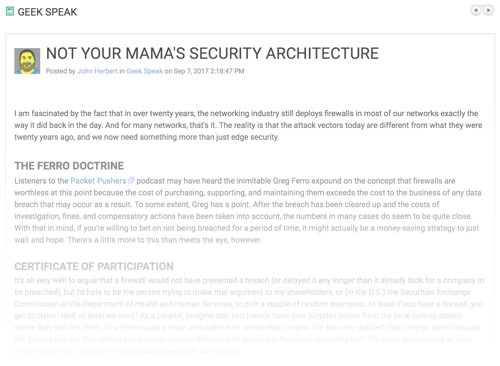0
From the start, one mission has driven us: to bring the economics and agility that the web-scale giants enjoy in networking to companies of all sizes.
We announced Cumulus Express at the start of the year with that mission front of mind. The response has exceeded our expectations and reaffirmed our belief that web-scale IT is something companies across the spectrum are serious about. open chassis based on Facebook Backpack — has helped us attract some amazing new customers within the Fortune 100, helping us boost bookings by more than 20%. An interesting insight from speaking to our customers is that established enterprises are looking to create a web-scale architecture with fixed and modular platforms. Both our fixed-form Cumulus Express offering as well as our modular platforms like Backpack cater to companies like those that need a joint solution that is easy to procure and quick to deploy. On average, the availability of Cumulus Express has cut the time it takes from initial conversation to live proof of concept (PoC) in half, meaning that our customers are seeing value faster.
But it isn’t just the Fortune 100 taking an interest; we’ve also seen uptake among other mainstream enterprises. For example, both Healthcare Realty, a major real estate trust, and Perth Radiological Clinic chose Express as a means of quickly expanding their existing Cumulus deployments. What’s more, we’re speaking to a whole range of other companies that are interested in following in their footsteps.
So how did we get here? Simple: we listened.
Many cloud architects we spoke with in the process of developing this product wanted more choice. Many companies were eager to build modern, web-scale networks, but needed the ability to deploy a PoC quickly before committing to the disaggregated model. This was particularly true among large, established enterprises. Others were already on board, but were used to buying their networking system as an appliance. We needed to create an option that would make buying Cumulus Linux — and getting a PoC up and running — quick and easy in both instances.
Enter Cumulus Express. With it, you get a fixed or modular switch preloaded with Cumulus Linux and a set of certified cables and optics. Offering our open networking software and high performance switching hardware in one ready-to-run package was one more way we could make web-scale networking more accessible to more companies and help them be successful.
It’s been a great year for us so far, but we never feel our work is done. I’ve always been steadfast in my belief that building great, enduring companies requires great products — built by listening to customers — so that’s what we’re going to continue to do. Keep sharing your feedback and ideas with us, because it fuels us to keep improving.
Alongside Cumulus Express, we’ve worked extremely hard to bring other standard-setting products like Host Pack to market and build further on our mission of bringing web-scale to the masses. What Cumulus Networks now has is the most mature offering on the market, so we’re perfectly placed to serve the demand for web-scale for years to come.
The post Proof that our customers’ success is our success appeared first on Cumulus Networks Blog.

 Extreme will purchase Brocade's networking assets directly from Brocade.
Extreme will purchase Brocade's networking assets directly from Brocade. New public cloud networking, compute, and storage features stomp on AWS, the company claims.
New public cloud networking, compute, and storage features stomp on AWS, the company claims.


 Heptio CTO Joe Beda claims greater Kubernetes reach will be achieved, not by a single technology, but by solving problems.
Heptio CTO Joe Beda claims greater Kubernetes reach will be achieved, not by a single technology, but by solving problems.